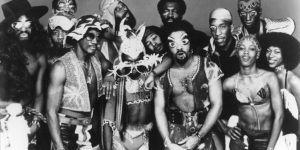CRAM SESSION: An intro to anonymous avant-garde icons The Residents
by Anthony Hansen
April 21, 2016
Read a primer on San Francisco's eyeball-helmeted surrealists peering back to 1969.
If you’ve only heard of The Residents in passing, you probably already know two things: 1) nobody knows who they are and 2) they’re pretty strange.
In fact, these two things are all that it’s really possible to know for sure, since so much of their mythology is based on hearsay and outright misinformation perpetuated by the band themselves (along with their management company, the Cryptic Corporation).
The story goes that they (allegedly) met in high school in Louisiana in the 1960s before (supposedly) striking out to California, and got their band name from (reportedly) having one of their demo tapes sent back to them in a package addressed to “The Residents” because they hadn’t provided a name on the return address. They then settled in San Francisco and decided to put out their material by starting their own record company, Ralph Records (OK, that part is actually true).
Of course, with the release of the new documentary film Theory of Obscurity: a film about The Residents, there is the chance that we may finally know the full story behind the band, though realistically it’ll most likely raise more questions than it answers.
Regardless, the band’s massive body of work speaks for itself – over 40 years’ worth of material dwelling on the fringes of what’s artistically acceptable, encompassing not only music but pioneering music videos, CD-ROMs and elaborate stage shows. Where does one even begin to make sense of it all? Read on.
Meet The Residents (1974)
If you’re going to indulge in weirdness for weirdness’ sake, it helps to be really, really, really weird. More than any subsequent Residents album, their debut seems to exist for no reason other than to baffle the listener into submission, from the opening suite of songs led by a tuneless disembowelment of Nancy Sinatra’s “These Boots Are Made For Walkin'” to the disastrous “N-Er-Gee Crisis Blues.”
In between, you get forays into opera, sort of (“Spotted Pinto Bean”), Christmas music, kinda (“Seasoned Greetings”) and the ungodly James Brown/Captain Beefheart hybrid “Infant Tango.” Though they would go on to accomplish bigger and better things, the noisy primitivism of Meet The Residents has a homemade charm all its own. True to form, the immediate follow-up (the utterly bonkers concept album Not Available) was shelved for four years because the band only wanted it issued once they’d completely forgotten about its existence. Of course.
Duck Stab!/Buster And Glen (1978)
The Residents’ first attempt at an album of “normal” songs – which is to say, they have recognizable song structures and actual discernable lyrics and that’s about it. Otherwise, the instrumental tones are as harsh and abrasive as ever, the melodies are almost entirely tuneless (though somehow quite catchy in spite of themselves), and the atmosphere is often deeply creepy.
Still, there’s something fascinating about hearing the band force their early sound into more song-like shapes, and there’s no denying that these songs have staying power: “Constantinople” and “Hello Skinny” are as close to ‘hits’ as the band ever produced. If you’re going to start anywhere, start here.
Eskimo (1979)
Possibly the most misunderstood Residents album, and easily their sharpest piece of conceptual satire. The alleged premise of the album is that it’s an audio document of Inuit life pre-colonization. Where they flip the concept on its head, however, is by deliberately constructing that audio document entirely from Western civilization’s own pre-conceptions of Inuit life, making it more of a snide comment on the way colonizers sentimentalize pre-colonial life without bothering to understand it on its own terms.
Heady stuff, but what of the album on a musical level? Well, if you thought The Residents’ music was weird, just wait until you hear their take on field recordings. Eskimo is a soundscape first and foremost, one that invokes a dream-like landscape halfway between the arctic and the surface of Mars. That said, what little actual “music” there is here goes a long way: the last few minutes of “The Festival Of Death” may actually be the most un-self-consciously beautiful passage in The Residents’ whole discography.
God In Three Persons (1988)
After 1980’s Commercial Album, The Residents spent a large chunk of the ’80s in a rut, producing one aimlessly self-indulgent album after another and generally living up the worst parts of their reputation as an avant-garde novelty band. In that context, God In Three Persons is, quite frankly, startling.
Not only was this the most serious album they’d done up to that point, but one completely unlike anything they’d attempted before: a short story in the form of a 60-minute-long poem written in iambic pentameter, set to a sparse, all-electronic soundtrack. The story itself is deeply disturbing, centring around a certain Mr. X’s increasingly destructive sexual fixation on one of a pair of conjoined twins with healing powers.
The lyrics are the real star here – heavy with allegorical symbolism, and so beautifully written that they leave 90% of all “poetic” rock songwriters in the dust. If you have an hour to spare and a strong stomach, this is their masterpiece, and one of the first signs of their creative rejuvenation to come.
Demons Dance Alone (2002)
The Residents spent the next decade or so experimenting with a more MIDI-based musical approach, with mixed results. While their albums remained intriguing on a lyrical and conceptual level, the actual music often had an unfortunate Casio-demo-setting quality that felt at odds with their reputation for innovation and restless experimentation.
Demons Dance Alone broke them out of this rut, though not in the way one might expect: rather than return them to the anarchic spirit of their earlier albums, it fully embraced a newfound compositional and emotional maturity, presenting some of the most conventionally melodic and open-hearted songs they’d ever written. It’s also a deeply sad album, its lyrics mostly dealing with the early stages of grief (as evidenced by the fact that the album is divided into three stages, its first two being “Loss” and, er, “Grief”).
It helps that the band is augmented by singer Molly Harvey, whose gorgeous, plaintive voice provides the album with some of its most striking moments. In all its vulnerability, Demons Dance Alone is as close as The Residents have ever come to unmasking themselves.
Animal Lover (2005)
A divisive album among fans, Animal Lover took The Residents’ increasingly dark musical and lyrical vision to its furthest extreme yet. Its most common themes are psychosis, religious hysteria, war and death, with the added twist that the liner notes detail the same stories in the lyrics as observed by animals who are mostly just baffled by human behaviour (for instance, the song “Mother No More” is about a woman whose son has returned from the army with severe PTSD, while the story in the liner notes is from the point of view of his cat who’s just annoyed that he doesn’t pet her anymore).
The music veers ominously between moments of sombre, ethereal beauty and jarring, chaotic bursts of noise, with an expanded sonic palette that emphasizes tuned percussion, group harmony vocals, and Nolan Cook’s violently off-kilter, Adrian Belew-esque guitarwork. Not one of their most uplifting efforts, but one that proved that, even 30 years into their career, they still had a whole lot of new tricks left in them yet.
Tags: Music, Featured, cram session, the residents





